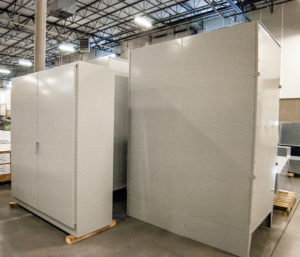 Electrical enclosures for utility uses come in a variety of different sizes. Their purpose is to house electrical distribution equipment such as transformers and metering units, as well as LV motor control centers in some cases. Electrical enclosures for utility uses are often located outdoors and therefore need to be resilient to prevailing environmental conditions which will range from rain, sleet, snow, ice and depending on locality dust storms. The construction of the electrical enclosures must ensure they can withstand all these environmental challenges, while providing security and safety systems to protect people from the equipment inside.
Electrical enclosures for utility uses come in a variety of different sizes. Their purpose is to house electrical distribution equipment such as transformers and metering units, as well as LV motor control centers in some cases. Electrical enclosures for utility uses are often located outdoors and therefore need to be resilient to prevailing environmental conditions which will range from rain, sleet, snow, ice and depending on locality dust storms. The construction of the electrical enclosures must ensure they can withstand all these environmental challenges, while providing security and safety systems to protect people from the equipment inside.
Types of electrical enclosures
Electrical enclosures come in a variety of shapes and sizes. For utility uses, the enclosures are manufactured from a variety of hard wearing material. The following types of enclosures are commonly used for utility purposes:
- Switchgear enclosures.
- Walk-in enclosures.
- Fiberglass cabinets.
- Pad mounted enclosures e.g. transformer pads.
- Multi-purpose apparatus enclosures.
- Sectionalizing cabinets.
- Pedestal enclosures.
Utility services requiring electrical enclosures
Utility enclosures serve a variety of purposes and some of them are outlined below:
- To house electrical metering equipment.
- Engine generator sets and controls can be housed in electrical enclosures.
- Radio repeater equipment can also be hosed in electrical enclosures which offer protection against weather conditions.
- Water and wastewater treatment facilities use electrical enclosures for pump protection as well as housing control switchgear.
- Utility companies also use electrical enclosures to protect transformers and high voltage switchgear from the elements. The enclosures can also be locked to restrict access and protect the general public.
- Roadside electrical connections and spare fuse cabinets.
Construction of electrical enclosures for utility use
Different construction methods are used to make and assemble electrical utility enclosures, depending on the material for construction. The most common construction materials are metals and composites such as:
- Fiberglass (glass reinforced fiberglass).
- Stainless steel.
- Galvanized iron.
- Molded high density polyethylene (HDPE).
- Mild steel with zinc primer for harsh environments.
Metallic enclosure are manufactured using advanced cutting, welding and metal forming technologies, while GRP cabinets are created using molding processes.
12 gauge Galvanized steel is used to make the main body of the electrical enclosure. A wash and phosphate coat is often applied on cabinets for outdoor use. Powder coating is also used for both indoor and outdoor cabinet finishing. Heavy duty butt hinges are used to secure cabinet door to body. In some instances e.g. for larger size continuous hinges are used. Optional accessories include the following:
- Locks and locking mechanisms.
- Terminal blocks.
- Back panels, barriers and shelves.
- Alternate finishes and paints.
Whatever the project you are specifying electrical enclosures for, there are off the shelf utility products. Using a Custom metal fabrication company to design and fabricate your electrical enclosures will insure you have the exact design and safety standards needed to complete your project.